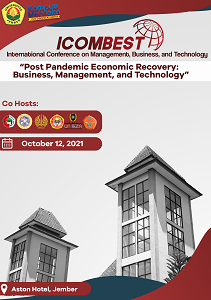MICROBIAL ASSAY OF CYPROFLOXACIN IN A BONE IMPLANT (CHITOSAN –BOVINE HYDROXYAPATITE WITH CROSS-LINKER GLUTARALDEHYDE) TOWARDS Staphylococcus aureus ATCC 25923
Abstract
Bone is one part of the body has an important roleto support the body's physiological functions (Porter
et al., 2009). Complications of bone diseases and
bone disorders caused by traumatic accidents may
result in a gap (defect) on the bone. The healing
process of damage or fracture is determined by the
level of trauma and soft tissue damage (Strobel et
al., 2011). Some cases of damage or injury to the
bone can not undergo natural recovery (Porter et al.,
2009). Therefore, clinical rehabilitation to overcome
the defect on the bone is expected to increase in line
with population growth (Mourino et al., 2010).
Treatment rehabilitation of bone cannot be
separated from the risk of infection complications.
Complications of bacterial infections can be treated
with antibiotics. However, in the case of a crack
(defect) occurs devascularity of bone tissue so that
the delivery of antibiotics to the target tissue to be
blocked. This resulted in the concentration of the
antibiotic to the target so low that it cannot
penetrate the bacteria. The condition can lead to
bacterial resistance to antibiotics (Li et al., 2010). A
high dose of antibiotics in the long term experienced
problems because it can cause systemic toxicity and
side effects (Mourino et al., 2010). To overcome
these problems, antibiotics can be done locally using
a certain drug delivery systems. The purpose of such
delivery systems is to provide drug concentration in
a specific location and ensure the drug release
profile for a certain time period (Dubnika et al.,
2012). Drug delivery locally has several advantages,
among others, (a) the systemic effects can be
avoided, (b) the amount of drugs used less and
secure, and (c) the efficacy and efficiency of drug
delivery locally can be achieved (Harmankaya et al.,
2013). Administration of antibiotics locally also to
minimize side effects and risk of toxicity compared
to administration of systemic antibiotics. In addition,
antibiotics locally also allows conduction in target
tissues with high concentration (Mourino et al.,
2010). The release of antibiotics on the target
network is expected to last continuously for a certain
time and achieve a greater concentration than the
minimum inhibitory concentration (MIC). Drug
delivery systems in a controlled manner (controlled
release system) can help increase the bioavailability
of antibiotics in target tissues. The system is
designed to release the drug at the expected
location at a rate appropriate for a certain time
period (Mourino et al., 2010). In a previous study
showed that a good composite is Ciprofloxacin: BHA:
Chitosan = 10:30:60. Cross linker with
glutaraldehyde (GA) 0.7% and with 10% active
ingredient Ciprofloxacin can release Cyprofloxacin
for 30 days (Hendradi et al, 2015). This research will
be seen potency against Staphilococcus aureus
ATCC25923 Ciprofloxacin for 30 days.
Published
2017-01-27
How to Cite
HENDRADI, Esti; HARIYADI, Dewi Melani; ADRIANTO, Muhammad Faris.
MICROBIAL ASSAY OF CYPROFLOXACIN IN A BONE IMPLANT (CHITOSAN –BOVINE HYDROXYAPATITE WITH CROSS-LINKER GLUTARALDEHYDE) TOWARDS Staphylococcus aureus ATCC 25923.
UNEJ e-Proceeding, [S.l.], p. 100-103, jan. 2017.
Available at: <https://jurnal.unej.ac.id/index.php/prosiding/article/view/3902>. Date accessed: 22 dec. 2024.
Section
General









